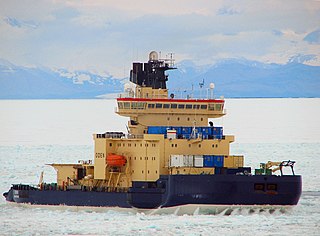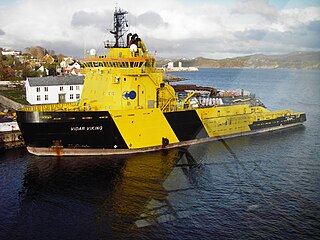Ships called Oden include:
- Oden, a Swedish Oden-class coastal defence ship, launched in 1896
- Oden (1957 icebreaker), broken up in 1988
- Oden (1988 icebreaker), a large Swedish icebreaker, built in 1988
Ships called Oden include:

RV Polarstern is a German research icebreaker of the Alfred Wegener Institute for Polar and Marine Research (AWI) in Bremerhaven, Germany. Polarstern was built by Howaldtswerke-Deutsche Werft in Kiel and Nobiskrug in Rendsburg, was commissioned in 1982, and is mainly used for research in the Arctic and Antarctica. The ship has a length of 118 metres and is a double-hulled icebreaker. She is operational at temperatures as low as −50 °C (−58 °F). Polarstern can break through ice 1.5 m thick at a speed of 5 knots. Thicker ice up to 3 m (9.8 ft) thick can be broken by ramming.

An icebreaker is a special-purpose ship or boat designed to move and navigate through ice-covered waters, and provide safe waterways for other boats and ships. Although the term usually refers to ice-breaking ships, it may also refer to smaller vessels, such as the icebreaking boats that were once used on the canals of the United Kingdom.

Oden is a large Swedish icebreaker, built in 1988 for the Swedish Maritime Administration. It is named after the Norse god Odin. First built to clear a passage through the ice of the Gulf of Bothnia for cargo ships, it was later modified to serve as a research vessel. Equipped with its own helicopter and manned by 15 crew members it has ample capacity to carry laboratory equipment and 80 passengers, functioning independently in harsh Polar ice packs of the Arctic and Antarctic seas. It was the first non-nuclear surface vessel to reach the North Pole, together with the German research icebreaker Polarstern. It has participated in several scientific expeditions in Arctic and Antarctica.

CCGS Louis S. St-Laurent is a Canadian Coast Guard Heavy Arctic Icebreaker. Louis S. St-Laurent's home port is St. John's, Newfoundland and Labrador and is stationed there with other vessels of the coast guard.
Oden is a Japanese food.

Ice class refers to a notation assigned by a classification society or a national authority to denote the additional level of strengthening as well as other arrangements that enable a ship to navigate through sea ice. Some ice classes also have requirements for the ice-going performance of the vessel.

Götaverken was a shipbuilding company that was located on Hisingen, Gothenburg. During the 1930s it was the world's biggest shipyard by launched gross registered tonnage. It was founded in 1841, and went bankrupt in 1989.
Thule has been the name of at least two ships of the Swedish Navy:
Seven ships of the French Navy have borne the name Astrolabe, after the instrument astrolabe

CCGS Captain Molly Kool is a Canadian Coast Guard converted medium class icebreaker. She was originally built as an icebreaking anchor handling tug Vidar Viking for Trans Viking Icebreaking & Offshore in 2001. The vessel was acquired by the Canadian Coast Guard in August 2018 and was commissioned in May of the next year after refit.

The Swedish Polar Research Secretariat is a government agency in charge of coordinating and promoting Swedish polar research activities. It is located in Stockholm, has more than 30 employees, and serves under the Ministry of Education and Research.
Malygin (Малыгин) may refer to one of the following icebreakers:
Atle may refer to:
Two ships have been named Sibir and one has been laid with planned same name:
Two ships have been named Arktika, Russian for the Arctic:
Two icebreakers and one class of icebreaker, have been named Taymyr, after the Taymyr Peninsula:
Two icebreakers have been named Vaygach:
Robert LeMeur was an icebreaking platform supply vessel used to support oil exploration in the Beaufort Sea. Built in 1982 by Burrard Yarrows Corporation in Vancouver, British Columbia, she was part of the fleet of Canadian icebreakers, drillships and support vessels operated by Canadian Marine Drilling (Canmar), the drilling subsidiary of Dome Petroleum and later Amoco Canada Petroleum Company.
Three icebreakers have been named Georgiy Sedov:
Two icebreakers have been named Rossiya, romanization of the Russian language word for "Russia" (Россия):